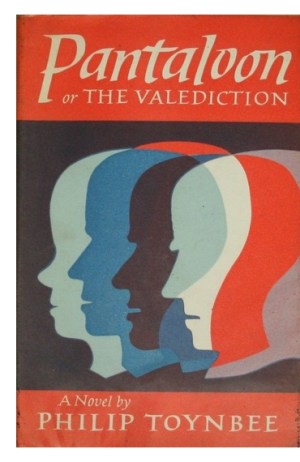
Jessica Mitford describes Faces of Philip: A Memoir of Philip Toynbee as “A record of events, not purporting to be a complete history, but treating of such matters as come within the personal knowledge of the writer, or are obtained from certain particular sources of information.” With such a qualification, one can excuse the fact that this book is likely to have been of more interest to those who knew Mitford and Toynbee that anyone who might read it then or now.
Philip Toynbee was the son of Arnold Toynbee, the best-known English historian of his time, whose magnum opus, A Study of History, is probably read today by barely more people than read any of his son’s books (all of them now out of print). He and Mitford became friends in the Thirties, when she married Esmond Romilly, with whom Toynbee was working as an anti-fascist activist. Mitford and Romilly moved to the U. S. in the late 1930s and she was stuck there when the war broke out. Romilly joined the Royal Canadian Air Force and was shot down on a mission over Germany and Mitford later married an American, Robert Treuhaft, and became an American citizen herself. Toynbee wrecked his first marriage and married again himself. Through it all, he and Mitford remained friends, writing each other often, seeing each other less often.
As Mitford makes clear without saying it outright, for much of his adult life Toynbee was an alcoholic and perhaps a manic depressive, given to such stunts as stripping to the nude while being returned to his Army unit after a riotous bender in town. But they shared a common sense of affection and fun, as reflected in Toynbee’s letter to Mitford in the late 1970s:
Believe it or not, I’ve just been asked to write your Times obituary. In some ways I see that this is tremendously one up on you–unless, of course, you’ve also been asked to write mine. On the other hand, it does give me a good deal of freedom, doesn’t it: I mean either you’ll never read it, or you’ll read it From Beyond where all is forgiven in every conceivable direction.
All love – and please don’t croak before I get this obit done. Drive carefully for next month or so.
Faces of Philip did offer Mitford the opportunity to pay tribute to Toynbee’s own magnum opus, a series of experimental novels in verse known as “Pantaloon.” Four volumes were published in the 1960s: Pantaloon (1961); Two Brothers (1964); A Learned City (1966); Views from a Lake (1968). As Mitford writes, “These have a small but devoted readership of fellow-poets and critics, some of whom discussed the series in their obituary articles.”
She provides a healthy sample of these assessments of “Pantaloon.” Patrick Leigh Fermor called it a “far-too-little-known, many volumed, and extremely brilliant narrative poem. Far more than a poetical feat of self-mockery, it is a most precious and perceptive documentation of a certain kind of growing-up, with all the problems, trends, dogmatic attractions and revolts to which the restless youth of the middle and late Thirties were prone.” To Stephen Spender, Pantaloon reflects Toynbee’s “serious, religious, ribald, self-mocking attitude to life. His friends will remember him as a poignant and moving personality who lived his life almost as if he were the ironically self-viewing hero of a fiction written by himself.”
Robert Nye, a champion of the experimental in literature, considered it “a remarkable achievement, perhaps a masterpiece…. It strikes me as one of the last authentic works of the spirit of modernism. After Toynbee’s death, Nye wrote that it was “one of the most important landmarks of post-war fiction in England. To re-read the individual volumes consecutively is to realise that here, at last, we have something that can be mentioned in the same breath as A la Recherche.”
In a review of Two Brothers, V. S. Pritchett wrote: “Another important reason for Mr Toynbee’s success is that he has hit on the right subject: the Grand Tour. This cannot fail in the hands of a restless, fervent .and cultivated writer who responds to the gay, the comic and the intense . . . Mr Toynbee has done a very fine thing.” Even The Times’ anonymous obituary writer described it as “A formidable achievement. Even now it is difficult to evaluate it confidently–passages of apparent rambling are juxtaposed with areas of intensely concentrated verbal experience–but it is never less than highly interesting.”
Despite this acclaim, “Pantaloon” has never been reissued and has now been out of print for 50 years. Mitford does mention that as someone who made his living as a book reviewer for most of the 1950s and 1960s, Toynbee took the reception of his own books with ironic humor. “There is only one review worth getting,” he once said. “The one that simply says ‘This is the Best Book Ever Written.'”
A brief excerpt from “The Third Day,” the third chapter in Pantaloon:
Once, in another age or life,
I was standing on the moving-staircase,
Going down.
Wheels and unseen chains were rattling
And feet were scraped on the metal slats of the steps.
Warm air was blown in our faces,
A warm wind breathed up the shaft
From the intricate dark mole-run of the Underground.
The blown air reeked of rubber and sparks
And a mild municipal disinfectant;
Of fagged-out breath and hasty scent,
Warm bodies and clothes.
I welcomed the old smell of a London lifetime.
Faces of Philip: A Memoir of Philip Toynbee is available free in electronic format on the Open Library: Link.
